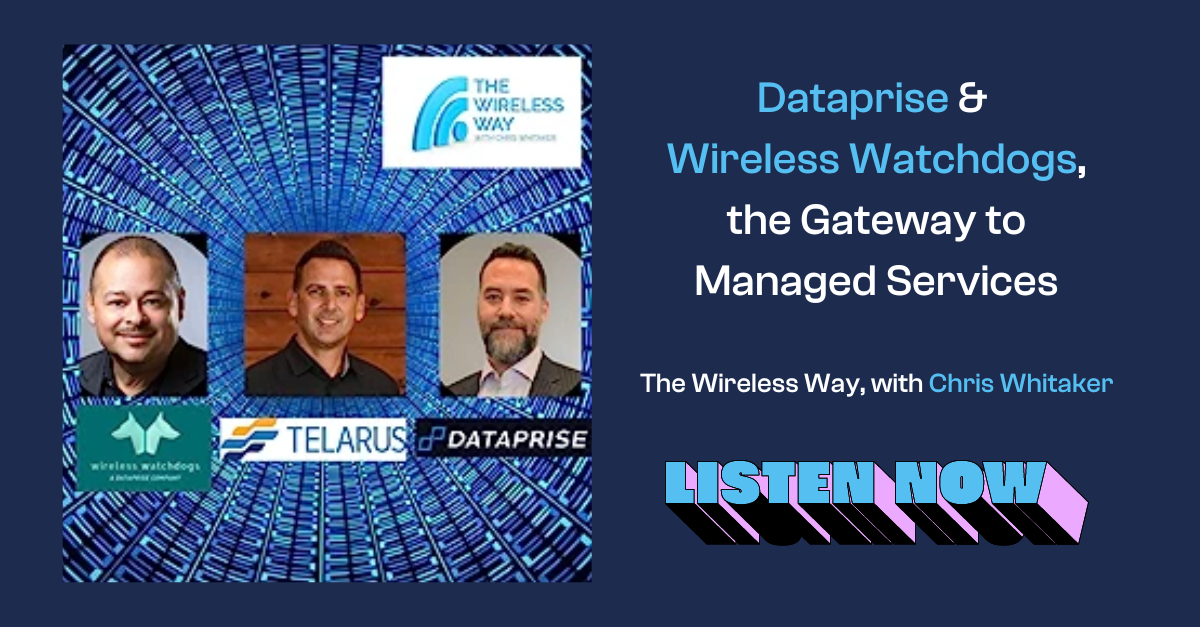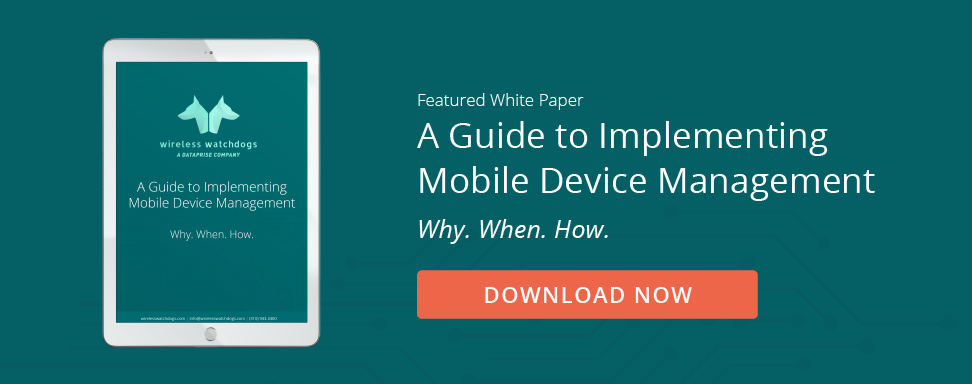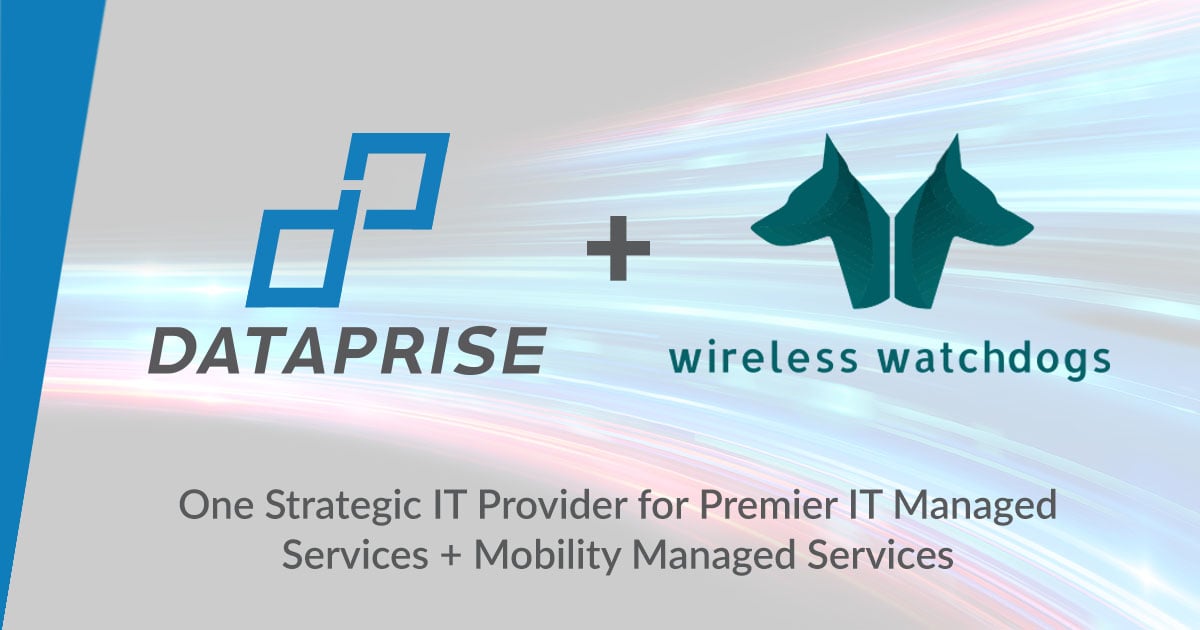In a recent The Wireless Way podcast, Wireless Watchdogs and parent company Dataprise were features as the gateway to managed services. This panel discussion featuring Jason Stein (VP of Cybersecurity at Telarus), John Gonzalez, (VP of Channel at Wireless Watchdogs), and Chaz Chalkley, VP of Channel at Dataprise covers how cybersecurity, mobility and IoT a are intertwined.
Listen to this lively conversation now!
Podcast Transcript: Sneak Peak
So you're in for a treat today, three great guys, Chaz Chalkley with Dataprise, John Gonzales with Wireless Watchdogs, and my good friend and teammate, Jason Stein, we dive into cybersecurity, mobility, and how they relate.
First of what I hope is many of having, you know, multiple guests on at a time. And talk about multiple advanced solutions and and multiple technologies. And today, I really like you have Jason Stein, John Gonzalez and and Chad with us from Dataprise, we're gonna lean into, you know, what does that look like, and what's what's the state of the industry, why would technology advisors and digital strategists need to be savvy on cybersecurity and even something on the other end of the spectrum is of that whole managed mobility, all these IoT devices, and mobile devices. So Jason Stein, thanks for making time.
What say you?
Thanks. Appreciate it. So, let's take a look back at what things looked like last year. We saw global criminal activity top eight point six trillion dollars.
It's continuing to go up. From an IoT mobility perspective, we have thirty four billion devices that have been identified as being on net, but one point five billion of them were compromised between January and June last year. That's just admitted to being compromised by the way. Then you sit there and say, okay, let's talk about the human element.
Now that everybody's working remote, we used to build the castle and put everybody in the castle and protect the castle. Now, with COVID, everybody's working remote. 82% of all breaches are caused by human error and we're only training our employees forty nine minutes a year is what the industry average is. But yet, there's $150B spam emails that are sent out every day. $18M websites are maliciously affected every single week.
How do you protect that employee now that we're working remote and how does mobility and IoT come into play, what can Wireless Watchdog and Dataprise do to help protect our customers now?
Now, that's great stats. Chaz, what's your thoughts on that? I mean, how are you seeing partners leverage Wireless Watchdog and Dataprise.
Great question. So, you know, on the managed services side, it's always key to the patching devices and to the deploying policies that really protect the entire environment. And what often goes overlooked, as Jason mentioned, are those IoT and mobile devices.
So having a strong MDM policy, and then backing that up with a solid MDR, EDR, SIEM-SOC type of solution to make sure you're capturing your entire environment is critical, right? Those mobile devices and IoTs are certainly entry points. Think of all the apps that you have on your phone, and how they can interact with other business related apps, right? So you really wanna control the policies and the permissions on the end user devices whether they're BYOD or company issued, and I'll turn over to John to double down on that.
John: We're in a mobile for first world. Mobile device security protects data from security threats and data breaches, unauthorized access to sensitive data, and even data loss, right, as a result of user error or stolen or misplaced device.
So by being able to protect these devices or for staff employees, as well as the organization, they need to have a well managed mobile device security plan, right, endpoint management cradle to the grave. We click, we play, right, there's a lot of things going on out there getting onto WiFi. So without the proper security or MDM implant in place, unfortunately, the only winners end up being the bad actors out there, and that can actually cripple a company.
So, it's huge. And from standpoint if we really think about it. All these devices, right, there's new devices that go out there and we really from a company standpoint with everything going on, really need to make sure that these devices are well managed, locked down to prevent these kind of breaches.
And John, what's the average savings? Watchdogs is typically saving about 20 to 40% immediately by their next billing cycle without switching their cell phone carrier.
Without having them switch SIM cards.
So this is found money, right? This is money that's staying there. It only changes are paying less, right? And they're paying, yeah, they're paying less for device and this funds other initiatives, right, like MDM, cyber security plans.
So the money's there, right? We're here to create that revenue stream and show clients where this overspending is going to use those that money to actually fund security for the organizations.
Jason, what do you see in the market mean? Are there bits is that are struggling to find the money? Or is that often an objection where they're like, hey, great idea. We should do it.
We just have the budget right now. One hundred percent of the time, the thing is that nobody really built an IT environment, thinking about security needs to be a cost center portion of that. It's been very reactive and not very proactive And so we're trying to always save them money in their voice and their data and their unified communications so that we can help justify and afford it.
But what really companies need to evaluate is how much money will it cost your organization if you're down for ten minutes? For one hour, for half of a day. Can you be able to recover from that plus the loss of reputation? So, you need that money as that safety net to make sure that you're identifying bad actors quicker so that you will not have downtime so that you can still maintain business as usual, but most companies we talked to have not budgeted for cybersecurity, was never part of the cost center.
That is so interesting. I mean, because you're right. It's not a problem till it's a problem. And when it's a problem, you don't have a solution for it, you're really gonna lose some money now. Right? I mean, if you don't have the money to invest in it now and and and you do have a cyber incident, maybe even worse situation, Right?
One hundred percent It's crazy, you know, and then security is getting more complex. Think about what it was like to be in IT ten years ago. You had a firewall. You had a VPN.
You know, now we're starting to see the complexity of security and layers of security. You need an endpoint detection and response to look at all of those devices and seeing what's get through. You need a SIEM to look at your logs. You need the security awareness training.
You still need those firewalls. But then we're getting more granular compliance now falls on IT. I mean it's just so much and what's in place today in a couple years, we're gonna see even more technology.
You now are moving away from an MPLS or a VPN and adopting SD WAN. Well then what comes out? You need to now protect your your users with that and then ZTNA with zero trust and how do you lock down your employees and put least privileged access so that if somebody gets compromised, they don't have access to every single thing so that you don't bring down the rest of your organization.
And John, we recently had a win this week with a partner. And I I saw him a few days ago, and he was like, man, great win. It was the easiest deal we've we've ever done. It was our second deal with Wireless Watchdogs.
And he goes, the part that I think the customer was most excited about, you know, saving thirty five percent was awesome. But getting that employee back and I of course, we knew what he meant, but just to say, what what do you mean by that? Well, I had a accounts payable employee that was their main job. They spent almost eight hours a day, five days a week just making sure we weren't being overcharged, and and auditing bills, and the fact that they got that whole employee back.
So now we're not really talking thirty five percent savings, this thirty five percent savings plus that whole headcount cost that they can apply towards another project possibly. Right? And and, Chad, how how do you see this playing in? I mean, have you had there been you know, partners or customers that have benefited from that scenario of saving money here and applying it over here to cyber.
Absolutely. Right? And and that that staff savings is a is a huge aspect of this. Right? So you free up that that staff member to then work with the partner or with an incoming MSP to really identify and scope what a proper managed IT environment looks like, whereas before they didn't have the time to do that, right? They're either putting out fires from mobility issues or on the phone with the carrier forever trying to resolve those things. So having the time to work with someone that can think strategically about the overall IT environment is key.
Without process and policy around these living and breathing devices, you have to people coming in, leaving, you have optimization, reporting in analytics, actionable analytics when we talk about effectiveness and efficiency.
Really giving that data to the upper management to really identify, you know, what's going on with these devices, these are business tools, right? So when we come in not only giving those analytics but able to offer that expertise okay, lead the client and alleviate the time in the guessing games that they're playing with the carriers so they can free up their time to focus on other core initiatives, right? To keep the company secure and up and running, that is a huge win. At the end of the day. So, you know, people with tower savings, yeah, it's gonna be there, but the real value is labor efficiency, control, accountability processes, in policy.
If I'm a partner listening right now, I'm thinking, okay, so you're telling me no site surveys no porting of phone numbers, no construction.
Don't have to schedule a tech visit, most likely.
They're saving money, they're rediscovering budget, they can apply toward other tech upgrades, which, you know, we're positioning cybersecurity as that tech upgrade.
Listen to the full Podcast for more great insights!
----------------
Need help with mobile device management and security? Download our free eBook, A Guide to Implementing Mobile Device Management. It's full of great information on establishing MDM goals and policies, securing your mobile devices, and the like, and you can grab it right here:







